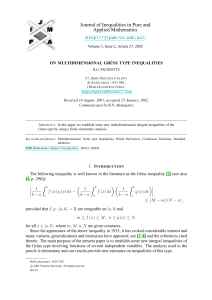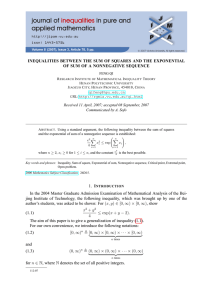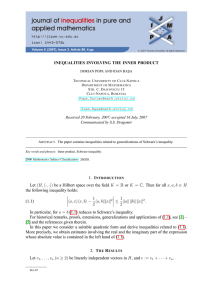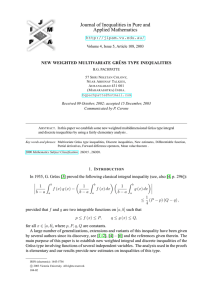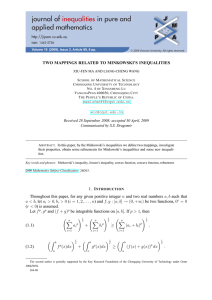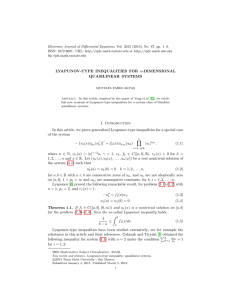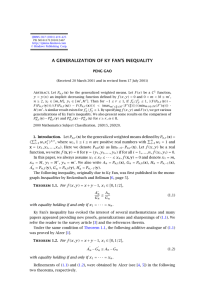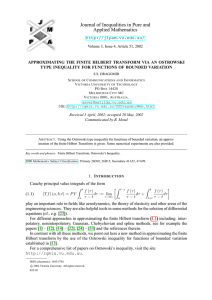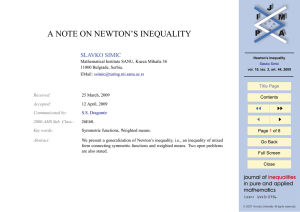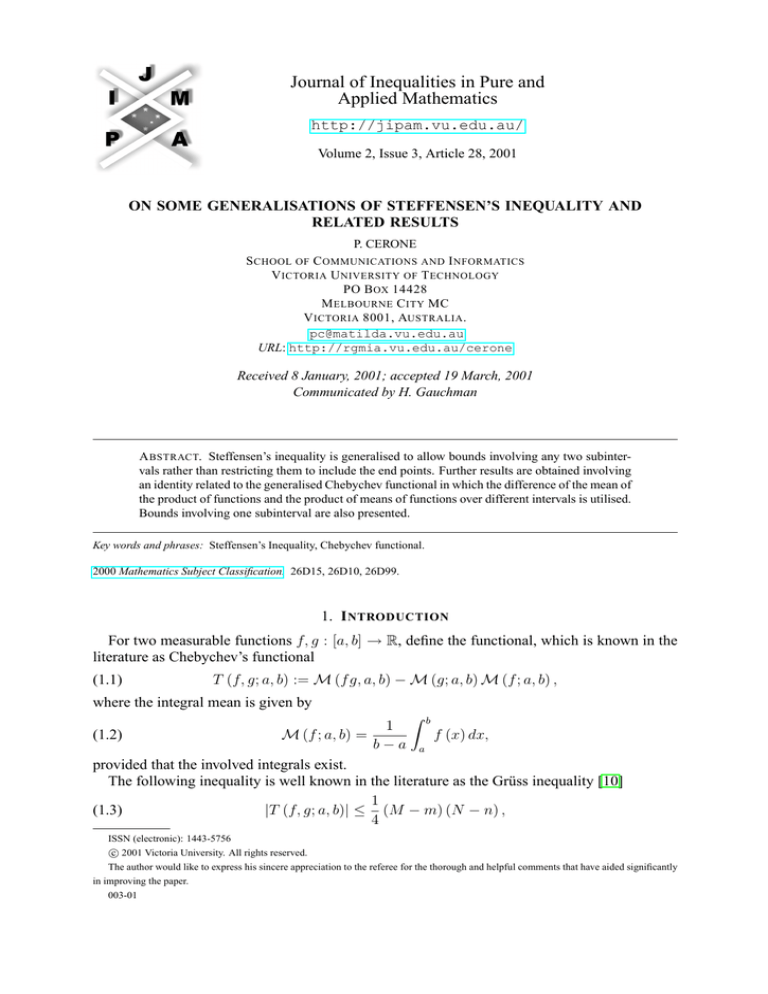
Journal of Inequalities in Pure and
Applied Mathematics
http://jipam.vu.edu.au/
Volume 2, Issue 3, Article 28, 2001
ON SOME GENERALISATIONS OF STEFFENSEN’S INEQUALITY AND
RELATED RESULTS
P. CERONE
S CHOOL OF C OMMUNICATIONS AND I NFORMATICS
V ICTORIA U NIVERSITY OF T ECHNOLOGY
PO B OX 14428
M ELBOURNE C ITY MC
V ICTORIA 8001, AUSTRALIA .
pc@matilda.vu.edu.au
URL: http://rgmia.vu.edu.au/cerone
Received 8 January, 2001; accepted 19 March, 2001
Communicated by H. Gauchman
A BSTRACT. Steffensen’s inequality is generalised to allow bounds involving any two subintervals rather than restricting them to include the end points. Further results are obtained involving
an identity related to the generalised Chebychev functional in which the difference of the mean of
the product of functions and the product of means of functions over different intervals is utilised.
Bounds involving one subinterval are also presented.
Key words and phrases: Steffensen’s Inequality, Chebychev functional.
2000 Mathematics Subject Classification. 26D15, 26D10, 26D99.
1. I NTRODUCTION
For two measurable functions f, g : [a, b] → R, define the functional, which is known in the
literature as Chebychev’s functional
(1.1)
T (f, g; a, b) := M (f g, a, b) − M (g; a, b) M (f ; a, b) ,
where the integral mean is given by
Z b
1
(1.2)
M (f ; a, b) =
f (x) dx,
b−a a
provided that the involved integrals exist.
The following inequality is well known in the literature as the Grüss inequality [10]
1
(1.3)
|T (f, g; a, b)| ≤ (M − m) (N − n) ,
4
ISSN (electronic): 1443-5756
c 2001 Victoria University. All rights reserved.
The author would like to express his sincere appreciation to the referee for the thorough and helpful comments that have aided significantly
in improving the paper.
003-01
2
P. C ERONE
provided that m ≤ f ≤ M and n ≤ g ≤ N a.e. on [a, b], where m, M, n, N are real numbers.
The constant 41 in (1.3) is the best possible.
Another inequality of this type is due to Chebychev (see for example [14, p. 207]). Namely,
if f, g are absolutely continuous on [a, b] and f 0 , g 0 ∈ L∞ [a, b] with kf 0 k∞ := ess sup |f 0 (t)| ,
t∈[a,b]
then
(1.4)
|T (f, g; a, b)| ≤
1
kf 0 k∞ kg 0 k∞ (b − a)2
12
1
and the constant 12
is the best possible.
Finally, let us recall a result by Lupaş ([11], see also [14, p. 210]), which states that:
(1.5)
|T (f, g; a, b)| ≤
1
kf 0 k2 kg 0 k2 (b − a) ,
2
π
provided f, g are absolutely continuous and f 0 , g 0 ∈ L2 [a, b]. The constant π12 is the best possible here.
For other Grüss type inequalities, see the books [13] and [14], and the papers [4]-[10], where
further references are given.
Recently, Cerone and Dragomir [3] have pointed out generalisations of the above results for
integrals defined on two different intervals [a, b] and [c, d]. They defined a generalised Chebychev functional involving the mean of the product of two functions, and the product of the
means of each of the functions, where one is over a different interval by
(1.6)
T (f, g; a, b, c, d) := M (f g, a, b) − M (g; a, b) M (f ; c, d) ,
with M (·, ·, ·) as defined in (1.2). They proved the following theorem.
Theorem 1.1. Let f, g : I ⊆ R → R be measurable on I and the intervals [a, b], [c, d] ⊂ I. In
addition, let m1 ≤ f ≤ M1 and n1 ≤ g ≤ N1 a.e. on [a, b] with n2 ≤ f ≤ N2 a.e. on [c, d].
Then the following inequalities hold
(1.7)
|T (f, g; a, b, c, d)|
1
≤ T (g; a, b) + M 2 (g; a, b) 2
1
× T (f ; a, b) + T (f ; c, d) + (M (f ; a, b) − M (f ; c, d))2 2
"
# 12
2
N1 − n 1
≤
+ M2 (g; a, b)
2
"
# 12
2 2
M1 − m 1
M2 − m 2
2
×
+
+ (M (f ; a, b) − M (f ; c, d))
,
2
2
where T (f ; a, b) ≡ T (f, f ; a, b) which is as given by (1.1) and M (f ; a, b) by (1.2).
Proof. The proof was based on the identity
(1.8)
1
T (f, g; a, b, c, d) =
(b − a) (d − c)
J. Inequal. Pure and Appl. Math., 2(3) Art. 28, 2001
Z bZ
d
g (x) (f (x) − f (y)) dydx,
a
c
http://jipam.vu.edu.au/
S TEFFENSEN ’ S I NEQUALITY
3
and the Cauchy-Buniakowski-Schwartz inequality for double integrals to give
|T (f, g; a, b, c, d)|2
2
Z bZ d
1
=
g (x) (f (x) − f (y)) dydx
(b − a) (d − c) a c
Z b Z d
Z b
1
2
2
≤
g (x) dx
(f (x) − f (y)) dydx
b−a a
a
c
= M2 (g; a, b) T (f, f, a, b, c, d) .
They noted that equivalent results to the second inequality in (1.7) could be obtained if (1.4)
and (1.5) relating to the Chebyshev and Lupaş inequalities were used in the first inequality in
(1.7).
The following inequality is due to Steffensen ([15], see also [14, p. 181]).
Theorem 1.2. Let f, g : [a, b] → R be integrable mappings on [a, b] such that f is nonincreasing
and 0 ≤ g (t) ≤ 1 for t ∈ [a, b]. Then
Z b
Z b
Z a+λ
(1.9)
f (t) dt ≤
f (t) g (t) dt ≤
f (t) dt,
b−λ
a
a
where
Z
λ=
(1.10)
b
g (t) dt.
a
Hayashi obtains a similar result [14, p. 182] which may ostensibly be obtained from Theorem
1.2 be replacing g (t) by g(t)
where A is some positive constant.
A
For Steffensen type inequalities with integrals over a measure space, see the work of Gauchman [9].
It may be noted that both the generalised Chebyshev functional (1.6) and Steffensen’s inequality (1.9) – (1.10) involve integrals of functions and of products of functions. The current
article aims at investigating the relationship further.
2. S TEFFENSEN T YPE R ESULTS FOR G ENERAL S UBINTERVALS
The following lemma will be useful for the results that follow.
Lemma 2.1. Let f, g : [a, b] → R be integrable mappings on [a, b]. Further, let [c, d] ⊆ [a, b]
Rb
with λ = d − c = a g (t) dt. Then the following identities hold. Namely,
Z
d
b
Z
f (t) dt −
(2.1)
c
f (t) g (t) dt
a
c
Z
=
Z
d
(f (d) − f (t)) g (t) dt +
(f (t) − f (d)) (1 − g (t)) dt
c
Z b
+
(f (d) − f (t)) g (t) dt
a
d
J. Inequal. Pure and Appl. Math., 2(3) Art. 28, 2001
http://jipam.vu.edu.au/
4
P. C ERONE
and
Z
b
d
Z
f (t) g (t) dt −
(2.2)
a
f (t) dt
c
Z
=
c
Z
d
(f (t) − f (c)) g (t) dt +
(f (c) − f (t)) (1 − g (t)) dt
a
c
Z b
+
(f (t) − f (c)) g (t) dt.
d
Proof. Let
Z
d
b
f (t) dt −
S (c, d; a, b) =
(2.3)
Z
c
f (t) g (t) dt, a ≤ c < d ≤ b,
a
then
Z
d
Z
(1 − g (t)) f (t) dt −
S (c, d; a, b) =
c
Z
=
c
c
b
Z
f (t) g (t) dt +
a
f (t) g (t) dt
d
d
Z
d
(1 − g (t)) dt
(1 − g (t)) (f (t) − f (d)) dt + f (d)
c
Z c
Z c
+
(f (d) − f (t)) g (t) dt − f (d)
g (t) dt
a
a
Z b
Z b
g (t) dt.
(f (d) − f (t)) g (t) dt − f (d)
+
d
d
The identity (2.1) is readily obtained on noting that
Z d
Z b
dt −
g (t) dt = 0.
f (d)
c
a
Identity (2.2) follows immediately from (2.1) and (2.3) on realising that (2.2) is S (d, c; b, a) or,
equivalently, −S (c, d; a, b).
Remark 2.2. If c = a in (2.1) and d = b in (2.2) then the identities obtained by Mitrinović [12]
using an idea of Apéry, are recaptured.
Theorem 2.3. Let f, g : [a, b] → R be integrable mappings on [a, b] and let f be nonincreasing.
Rb
Further, let 0 ≤ g (t) ≤ 1 and λ = a g (t) dt = di − ci , where [ci , di ] ⊂ [a, b] for i = 1, 2 and
d1 ≤ d2 .
Then the result
Z d1
Z b
Z d2
f (t) dt + R (c1 , d1 ) ,
f (t) g (t) dt ≤
f (t) dt − r (c2 , d2 ) ≤
(2.4)
a
c2
c1
holds where,
Z
b
(f (c2 ) − f (t)) g (t) dt ≥ 0
r (c2 , d2 ) =
d2
and
Z
c1
(f (t) − f (d1 )) g (t) dt ≥ 0.
R (c1 , d1 ) =
a
J. Inequal. Pure and Appl. Math., 2(3) Art. 28, 2001
http://jipam.vu.edu.au/
S TEFFENSEN ’ S I NEQUALITY
5
Proof. From (2.1) and (2.3) of Lemma 2.1
Z c1
S (c1 , d1 ; a, b) +
(f (t) − f (d1 )) g (t) dt
a
Z d1
Z b
=
(f (t) − f (d1 )) (1 − g (t)) dt +
(f (d1 ) − f (t)) g (t) dt ≥ 0
c1
d1
by the assumptions of the theorem.
Hence, from (2.3)
Z d1
Z c1
Z b
f (t) dt +
(f (t) − f (d1 )) g (t) dt −
f (t) g (t) dt ≥ 0
c1
a
a
and thus the right inequality is valid.
Now, from (2.2) and (2.3) of Lemma 2.1
Z b
− S (c2 , d2 ; a, b) +
(f (c2 ) − f (t)) g (t) dt
d2
c2
Z
Z
d2
(f (t) − f (c2 )) g (t) dt +
=
a
(f (c2 ) − f (t)) (1 − g (t)) dt ≥ 0
c2
from the assumptions.
Thus, from (2.3)
Z
Z b
f (t) g (t) dt −
d2
f (t) dt −
c2
a
b
Z
(f (c2 ) − f (t)) g (t) dt ≥ 0,
d2
giving the left inequality.
Both r (c2 , d2 ) and R (c1 , d1 ) are nonnegative since f is nonincreasing and g is nonnegative.
The theorem is now completely proved.
Remark 2.4. If in Theorem 2.3 we take c1 = a and so d1 = a + λ, then R (a, a + λ) = 0.
Further, taking d2 = b so that c2 = b − λ gives r (b − λ, b) = 0. The Steffensen inequality (1.9)
is thus recaptured. Since (1.10) holds, then c2 ≥ a and d1 ≤ b giving [ci , di ] ⊂ [a, b]. Theorem
2.3 may thus be viewed as a generalisation of the Steffensen inequality as given in Theorem
1.2, to allow for two equal length subintervals that are not necessarily at the ends of [a, b].
It may be advantageous at times to gain coarser bounds that may be more easily evaluated.
The following corollary examines this aspect.
Corollary 2.5. Let the conditions of Theorem 2.3 hold. Then
Z b
Z b
(2.5)
f (t) dt − (b − d2 ) f (c2 ) ≤
f (t) g (t) dt
c2
a
Z
d1
f (t) dt − (c1 − a) f (d1 ) .
≤
a
Proof. From Theorem 2.3 on using the fact that 0 ≤ g (t) ≤ 1, gives
Z b
(f (c2 ) − f (t)) g (t) dt
0 ≤ r (c2 , d2 ) =
d2
Z
b
Z
b
(f (c2 ) − f (t)) dt = (b − d2 ) f (c2 ) −
≤
d2
J. Inequal. Pure and Appl. Math., 2(3) Art. 28, 2001
f (t) dt
d2
http://jipam.vu.edu.au/
6
P. C ERONE
and so
Z
d2
Z
d2
f (t) dt − r (c2 , d2 ) ≥
c2
b
Z
f (t) dt − (b − d2 ) f (c2 ) +
f (t) dt.
c2
d2
Combining the two integrals produces the left inequality of (2.5). Similarly,
Z c1
Z c1
(f (t) − f (d1 )) g (t) dt ≤
f (t) dt − (c1 − a) f (d1 ) ,
0 ≤ R (c1 , d1 ) =
a
a
producing
Z
d1
Z
d1
f (t) dt + R (c1 , d1 ) ≤
c1
f (t) dt − (c1 − a) f (d1 )
a
giving the right inequality.
Remark 2.6. If we take c1 = a and so d1 = a + λ and d2 = b such that c2 = b − λ then (2.5)
again recaptures Steffensen’s inequality as given in Theorem 1.2.
The following lemma produces alternative identities to those obtained in Lemma 2.1. The
current identities involve the integral mean of f (·) over the subinterval [c, d].
Lemma 2.7. Let f, g : [a, b] → R be integrable mappings on [a, b]. Define
Z x
g (t) dt
G (x) =
a
and
λ = G (b) = d − c
where [c, d] ⊂ [a, b].
The following identities hold
Z
Z b
f (x) g (x) dx −
(2.6)
d
Z
G (x) df (x)
a
c
a
b
f (y) dy = λ [f (b) − M (f ; c, d)] −
and
Z
d
Z
b
c
b
[λ − G (x)] df (x) ,
f (x) g (x) dx = λ [M (f ; c, d) − f (a)] −
f (y) dy −
(2.7)
Z
a
a
where M (f ; c, d) is the integral mean of f (·) over [c, d].
Proof. Consider
b
Z
Z
f (x) g (x) dx −
L :=
f (y) dy
a
c
then from the postulates G(b)
= 1 giving
d−c
Z b
L=
f (x) g (x) dx −
a
d
1
d−c
Z
b
Z
d
g (x) dx
a
f (y) dy.
c
Combining the integrals gives
Z
(2.8)
b
g (x) [f (x) − M (f ; c, d)] dx,
L=
a
where M (f ; c, d) is the integral mean of f over [c, d] as given by (1.2).
Integration by parts from (2.8) gives
b Z b
L = G (x) [f (x) − M (f ; c, d)] −
G (x) df (x)
a
J. Inequal. Pure and Appl. Math., 2(3) Art. 28, 2001
a
http://jipam.vu.edu.au/
S TEFFENSEN ’ S I NEQUALITY
and so
Z
7
b
L = λ [f (b) − M (f ; c, d)] −
G (x) df (x)
a
since G (b) = λ and G (a) = 0.
Now for the second identity.
Let
Z
d
Z
f (y) dy −
U :=
c
b
f (x) g (x) dx
a
then, from (2.6),
b
Z
U = −L = −λ [f (b) − M (f ; c, d)] +
G (x) df (x) .
a
Hence
Z
U = λ [M (f ; c, d) − f (a)] − λ [f (b) − f (a)] +
b
G (x) df (x)
a
and so combining the last two terms gives (2.7).
Theorem 2.8. Let f, g : [a, b] → RRbe integrable mappings on [a, b] and let f be nonincreasing.
x
Further, let g (t) ≥ 0 and G (x) = a g (t) dt with λ = G (b) = di − ci where [ci, di ] ⊂ [a, b] for
i = 1, 2 and d1 < d2 . Then
Z d2
(2.9)
f (y) dy − λ [M (f ; c2 , d2 ) − f (b)]
c2
Z
b
≤
Z
d1
f (x) g (x) dx ≤
a
f (y) dy + λ [f (a) − M (f ; c1 , d1 )]
c1
where d2 > d1 .
Proof. From (2.6) together with the facts that f is nonincreasing and g (t) ≥ 0 then
Z b
G (x) df (x) ≥ 0
−
a
gives
b
Z
Z
d2
f (x) g (x) dx −
a
f (y) dy + λ [f (b) − M (f ; c2 , d2 )] ≥ 0
c2
and so the left inequality is obtained.
Similarly, from (2.7) and the postulates we have
Z b
[λ − G (x)] df (x) ≥ 0,
−
a
which gives
Z
d1
Z
b
f (x) g (x) dx ≥ 0.
f (y) dy + λ [M (f ; c1 , d1 ) − f (a)] −
a
c1
Remark 2.9. The lower and upper inequalities in (2.9) may be simplified to λf (b) and λf (a)
respectively since
Z d
f (y) dy = λM (f ; c, d) .
c
J. Inequal. Pure and Appl. Math., 2(3) Art. 28, 2001
http://jipam.vu.edu.au/
8
P. C ERONE
That is,
b
Z
λf (b) ≤
(2.10)
f (x) g (x) dx ≤ λf (a) .
a
The result should not be overly surprising since it may be obtained directly from the postulates
since
Z
Z
Z
b
x∈[a,b]
b
g (x) dx ≤
inf f (x)
a
b
f (x) g (x) dx ≤ sup f (x)
x∈[a,b]
a
g (x) dx.
a
As a referee suggested, the result (2.10) readily follows on noting that
Z b
g (x) [f (x) − f (b)] dx ≥ 0
a
and
Z
b
f (x) [f (a) − f (x)] dx ≥ 0
a
.
The motivation behind Lemma 2.7 and Theorem 2.8 was to obtain a Steffensen like inequality
and it was not predictable in advance that the result would reduce to (2.10).
3. S TEFFENSEN AND THE G ENERALISED C HEBYSHEV F UNCTIONAL
Bounds will be obtained for the difference between the integral of the product of two functions from the integral over a subinterval of one of the functions.
Theorem 3.1. Let f, g : [a, b] → R be integrable mappings on [a, b] such that f is nonincreasing
Rb
and 0 ≤ g (t) ≤ 1 for t ∈ [a, b]. Further, let [c, d] ⊆ [a, b] with λ = d − c = a g (t) dt, then the
following inequality holds. Namely,
Z b
Z d
(3.1)
|S| : = f (x) g (x) dx −
f (y) dy a
c
"
1
≤ (b − a)
+
4
+
λ
b−a
f (c) − f (d)
2
"
×
f (a) − f (b)
2
2
# 12
2
where M (f ; a, b) is the integral mean.
Rb
Proof. Since d − c = a g (t) dt, then
Z b
S=
f (x) g (x) dx −
a
2 # 12
2
+ (M (f ; a, b) − M (f ; c, d))
1
d−c
Z
b
Z
g (x) dx
a
,
d
f (y) dy
c
that is
Z
(3.2)
S=
b
Z
b
f (x) g (x) dx − M (f ; c, d)
a
g (x) dx,
a
where M (f ; c, d) is as defined by (1.2).
Thus, from (3.2), S may be expressed in terms of the generalised Chebyshev functional as
defined in (1.6), namely
(3.3)
S = (b − a) T (f, g; a, b, c, d)
J. Inequal. Pure and Appl. Math., 2(3) Art. 28, 2001
http://jipam.vu.edu.au/
S TEFFENSEN ’ S I NEQUALITY
9
and so, from (1.7)
(3.4)
|S| = (b − a) |T (f, g; a, b, c, d)|
"
2 # 12
λ
≤ (b − a) T (g; a, b) +
b−a
1
× T (f ; a, b) + T (f ; c, d) + (M (f ; a, b) − M (f ; c, d))2 2 ,
where
T (f ; a, b) = M f 2 ; a, b − (M (f ; a, b))2
λ
and M (g; a, b) = b−a
.
Hence, using the second inequality from (1.7) and (3.4) produces the stated result (3.1) upon
using (1.3) and the facts that f is nonincreasing and 0 ≤ g (t) ≤ 1 .
Remark 3.2. If we had more stringent conditions on f 0 and g 0 such that the Chebyshev and
Lupaş results (1.4) and (1.5) could be utilised in (3.4), then bounds in terms of the k·k∞ and
k·k2 norms of the derivatives would result. This will not be pursued further here however.
The following theorem expresses S as a double integral over a rectangular region to obtain
bounds for the Steffensen functional.
Theorem 3.3. Let the conditions of Theorem 3.1 hold. The following inequality is then valid.
Namely,
Z b
Z d
(3.5)
|S| : = f (x) g (x) dx −
f (y) dy a
c
4
≤ (a + b + c + d) M (f ; c, d) −
µ (f ; c, d)
d−c
Z c
Z b
+
f (x) dx −
f (x) dx
a
d
≤ (c − a) f (a) − (b − d) f (b) + (a + b + c + d) f (c)
−2 (d + c) f (d) ,
where M (f ; c, d) is the integral mean and
Z
µ (f ; c, d) =
(3.6)
d
xf (x) dx.
c
Proof. From (3.3) and (1.8)
(3.7)
Z Z
1 b d
|S| =
g
(x)
(f
(x)
−
f
(y))
dydx
d−c a c
Z bZ d
kgk∞
≤
|f (x) − f (y)| dydx,
d−c a c
where kgk∞ := ess sup |g (x)| = 1, from the postulates.
x∈[a,b]
Thus,
(3.8)
1
|S| ≤
d−c
J. Inequal. Pure and Appl. Math., 2(3) Art. 28, 2001
Z bZ
d
|f (x) − f (y)| dydx := I.
a
c
http://jipam.vu.edu.au/
10
P. C ERONE
Now, using the fact that f is nonincreasing and that [c, d] ⊆ [a, b], we have
Z cZ d
Z dZ x
(d − c) I =
(f (x) − f (y)) dydx +
(f (y) − f (x)) dydx
a
c
c
c
Z dZ d
Z bZ d
+
(f (x) − f (y)) dydx +
(f (y) − f (x)) dydx
c
x
d
c
Z c
Z d
= (d − c)
f (x) dx − (c − a)
f (y) dy
a
c
Z dZ x
Z d
+
f (y) dydx −
(x − c) f (x) dx
c
c
c
Z d
Z dZ d
+
(d − x) f (x) dx −
f (y) dydx
c
c
x
Z d
Z b
+ (b − d)
f (y) dy − (d − c)
f (x) dx
c
d
Z d
Z c
Z b
f (x) dx −
f (x) dx +
[a + b + c + d − 4x] f (x) dx.
= (d − c)
a
d
c
Here we have used the facts that
Z dZ x
Z
d
(d − x) f (x) dx
f (y) dydx =
c
c
c
and
Z
d
Z
d
Z
(x − c) f (x) dx.
f (y) dydx =
c
x
c
Some elementary simplification gives
Z b
Z c
f (x) dx +
f (x) dx −
(3.9)
I=
a
d
d
4
d−c
Z
d
c
a+b+c+d
− x f (x) dx
4
and hence the first inequality results.
The coarser inequality is obtained using the fact that f is nonincreasing, giving, from (3.9)
Z d
4
f (d)
xdx,
I ≤ (c − a) f (a) − (b − d) f (b) + (a + b + c + d) f (c) −
d−c
c
which upon simplification gives the second inequality in (3.5). The theorem is thus completely
proved.
Corollary 3.4. Let the conditions of Theorem 3.1 hold. Then
Z b
(3.10)
−2cM (f ; c, d) − φ (c, d) ≤
f (x) g (x) dx ≤ 2dM (f ; c, d) + φ (c, d) ,
a
where
Z
(3.11)
φ (c, d) = (a + b) M (f ; c, d) +
c
Z
f (x) dx −
a
b
f (x) dx −
d
4
µ (f ; c, d)
d−c
with M (f ; c, d) being the integral mean and µ (f ; c, d) the mean of f over the subinterval [c, d]
given by (1.2) and (3.6) respectively.
J. Inequal. Pure and Appl. Math., 2(3) Art. 28, 2001
http://jipam.vu.edu.au/
S TEFFENSEN ’ S I NEQUALITY
Proof. From (3.5) and (3.8) we have that
Z b
Z
−I ≤
f (x) g (x) dx −
a
11
d
f (y) dy ≤ I
c
so that from (3.9)
d
Z
I = φ (c, d) −
f (x) dx
c
giving the result as stated after some minor algebra.
Rb
Remark 3.5. Equation (3.10) gives bounds for a f (x) g (x) dx in terms of information known
over the subinterval [c, d]. Let [c1 , d1 ] and [c2 , d2 ] be two such subintervals with d1 < d2 and
di − ci = λ. Then
Z b
(3.12)
m≤
f (x) g (x) dx ≤ M,
a
where
M = min {2d1 M (f ; c1 , d1 ) + φ (c1 , d1 ) , 2d2 M (f ; c2 , d2 ) + φ (c2 , d2 )}
and
m = max {−2c1 M (f ; c1 , d1 ) − φ (c1 , d1 ) , −2c2 M (f ; c2 , d2 ) − φ (c2 , d2 )} ,
with φ (·, ·) being as given in (3.11).
Particularising the result (3.12) on taking d2 = b and hence c2 = b − λ, c1 = a and so
d1 = a + λ, produces bounds in terms of subintervals at the ends of [a, b]. That is,
Z b
(3.13)
me ≤
f (x) g (x) dx ≤ Me ,
a
where
(3.14)
Me = min{2 (a + λ) M (f ; a, a + λ) + φ (a, a + λ) ,
2bM (f ; b − λ, b) + φ (b − λ, b)}
and
me = max{−2aM (f ; a, a + λ) − φ (a, a + λ) ,
−2 (b − λ) M (f ; b − λ, b) − φ (b − λ, b)}
with φ (·, ·) defined in (3.11).
For (3.14) on using (3.11), (1.2) and (3.6) gives
Z
b
4
f (x) dx −
φ (a, a + λ) = (a + b) M (f ; a, a + λ) −
λ
a+λ
a+λ
Z
xf (x) dx
a
and
Z
4 b
φ (b − λ, b) = (a + b) M (f ; b − λ, b) +
f (x) dx −
xf (x) dx.
λ b−λ
a
R a+λ
It may be possible that Me can either be tighter or coarser than the a f (x) dx bound in (1.9)
Rb
and similarly with me and b−λ f (x) dx.
Z
J. Inequal. Pure and Appl. Math., 2(3) Art. 28, 2001
b−λ
http://jipam.vu.edu.au/
12
P. C ERONE
R EFERENCES
[1] P. CERONE AND S.S. DRAGOMIR, On some inequalities for the expectation and variance, Korean
J. Comp. & Appl. Math., 8(2) (2001), 357–380.
[2] P. CERONE AND S.S. DRAGOMIR, On some inequalities arising from Montgomery’s identity, J.
Compt. Anal. Applics., 6(2) (2001), 117–128.
[3] P. CERONE AND S.S. DRAGOMIR, Generalisations of the Grüss, Chebychev and Lupaş inequalities for integrals over different intervals, Inter. J. Appl. Math., (accepted).
[4] S.S. DRAGOMIR, Grüss inequality in inner product spaces, The Australian Math Soc. Gazette,
26(2) (1999), 66–70.
[5] S.S. DRAGOMIR, A generalization of Grüss’ inequality in inner product spaces and applications,
J. Math. Anal. Appl., 237 (1999), 74–82.
[6] S.S. DRAGOMIR, A Grüss type integral inequality for mappings of r-Hölder’s type and applications for trapezoid formula, Tamkang J. of Math., 31(1) (2000), 43–48.
[7] S.S. DRAGOMIR, Some integral inequalities of Grüss type, Indian J. of Pure and Appl. Math.,
31(4) (2000), 397-415.
[8] S.S. DRAGOMIR AND I. FEDOTOV, An inequality of Grüss’ type for Riemann-Stieltjes integral
and applications for special means, Tamkang J. of Math., 29(4) (1998), 286–292.
[9] H. GAUCHMAN, A Steffensen type inequality, J. Ineq. Pure and Appl. Math., 1(1) (2000), Art. 3.
http://jipam.vu.edu.au/v1n1/009_99.html
Rb
1
[10] G. GRÜSS, Über das Maximum des absoluten Betrages von b−a
a f (x)g(x)dx −
Rb
Rb
1
f (x)dx a g(x)dx, Math. Z. , 39(1935), 215–226.
(b−a)2 a
[11] A. LUPAŞ, The best constant in an integral inequality, Mathematica, 15(38) (2) (1973), 219–222.
[12] D.S. MITRINOVIĆ, The Steffensen inequality, Univ. Beograd. Publ. Elektrotehn. Fak. Ser. Mat.
Fiz., No. 247-273 (1969), 1–14.
[13] D.S. MITRINOVIĆ, J.E. PEČARIĆ AND A.M. FINK, Classical and New Inequalities in Analysis,
Kluwer Academic Publishers, Dordrecht, 1993.
[14] J. PEČARIĆ, F. PROCHAN AND Y. TONG, Convex Functions, Partial Orderings and Statistical
Applications, Academic Press, San Diego, 1992.
[15] J.F. STEFFENSEN, On certain inequalities between mean values, and their applications to actuarial
problems, Strand. Aktuarietids, (1918), 82–97.
J. Inequal. Pure and Appl. Math., 2(3) Art. 28, 2001
http://jipam.vu.edu.au/

